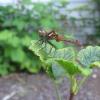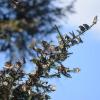As the Western Monarch Thanksgiving Count kicks into full swing, trained “monarch spotters” will be documenting overwintering populations at hundreds of sites across California. While you may be familiar with the impressive monarch clusters, family-friendly amenities, and helpful docents at Pismo Beach, Pacific Grove, Natural Bridges, and Ardenwood Historic Farm, there are many more places monarchs overwinter along the coast. Monarch enthusiasts at all levels can take pleasure in tracking down large collections of the colorful butterflies at some of these lesser-known overwintering sites.
Viewing Etiquette
- Enjoy watching the butterflies with family and friends, but leave pets at home.
- Binoculars and cameras can help you get a close-up view without moving in too close.
- Avoid loud noises, smoke, or disturbing the trees monarchs roost in.
- Stay behind any posted signs or fencing.
Viewing Tips
- The best time to see monarchs in their clusters are in the early morning or on cool, overcast days.
- The best time to see monarchs flying about in search of nectar, water, and good places to sun is during warm, sunny days.
- The sites listed below are all publicly owned and accessible; please note that state park sites may require park fees.
Viewing Opportunities
Butterflies at the Beach
Lighthouse Field State Beach, City of Santa Cruz, Santa Cruz County
Just down the road from Natural Bridges State Park, the Monterey cypress and eucalyptus grove at Lighthouse Field usually host as many or more butterflies as Natural Bridges (12,000 in 2015!) The park area forms the northern boundary of Monterey Bay and is one of the last open headlands in California. Surfers, tourists, birds, and wintering monarch butterflies are all drawn to this area. The park is open to the public from 7 a.m. to sunset year-round.
The “Butterfly Tree” of Berkeley
Berkeley Aquatic Park, City of Berkeley, Alameda County
Last fall, over 1,000 monarchs were spotted clustering on an ash tree in downtown Berkeley’s Aquatic Park, where they have never been reported before. Early reports from this season indicate the butterflies are returning, but in smaller numbers than last year and that the clusters have switched to a nearby eucalyptus tree. Park hours are 6 a.m. to 10 p.m. daily.
A View of the Bay
Albany Hill Park, City of Berkeley, Alameda County
At the top of Albany Hill is an oasis for monarchs who cluster by the 10s, 100s, or around 1,000 butterflies depending on the year. Many hiking trails facilitate the enjoyment of the park, and an impromptu rope swing and bench make for fine viewing of flitting butterflies during sunsets over the San Francisco Bay. The park is open to the public daily.
The Monarch Grove in Goleta
Ellwood Main, City of Goleta, Santa Barbara County
At this former ranch and eucalyptus nursery, remnants of the original groves have created a favorable setting for overwintering monarchs. Ellwood typically hosts thousands of butterflies November through February. The site is open sunrise to sunset with no admission fee, but the City of Goleta does accept donations to support the Monarch Butterfly Docent Program.
Birds and Butterflies
Morro Bay State Park, San Luis Obsipo County
Situated in scenic Morro Bay, the park contains several butterfly overwintering sites including at a campground which hosted over 4,000 butterflies last year. On the bay’s northeast edge is a pristine saltwater marsh that supports a thriving bird population. Also of interest is the Museum of Natural History which offers activities for all ages: nature walks, exhibits, lectures, puppet shows, videos, docent-led tours and special events. Hours of operation vary, but the park is open Thanksgiving, Christmas, and New Year's Day.




